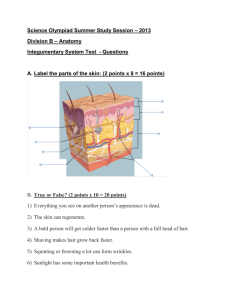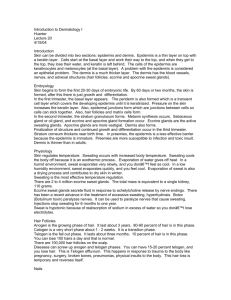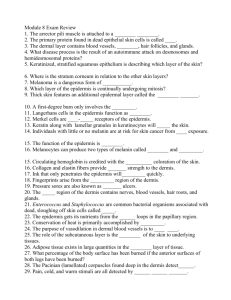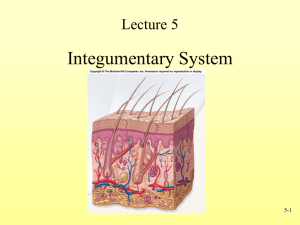Anatomy I Integumentary System Answer Key Write true if the
advertisement
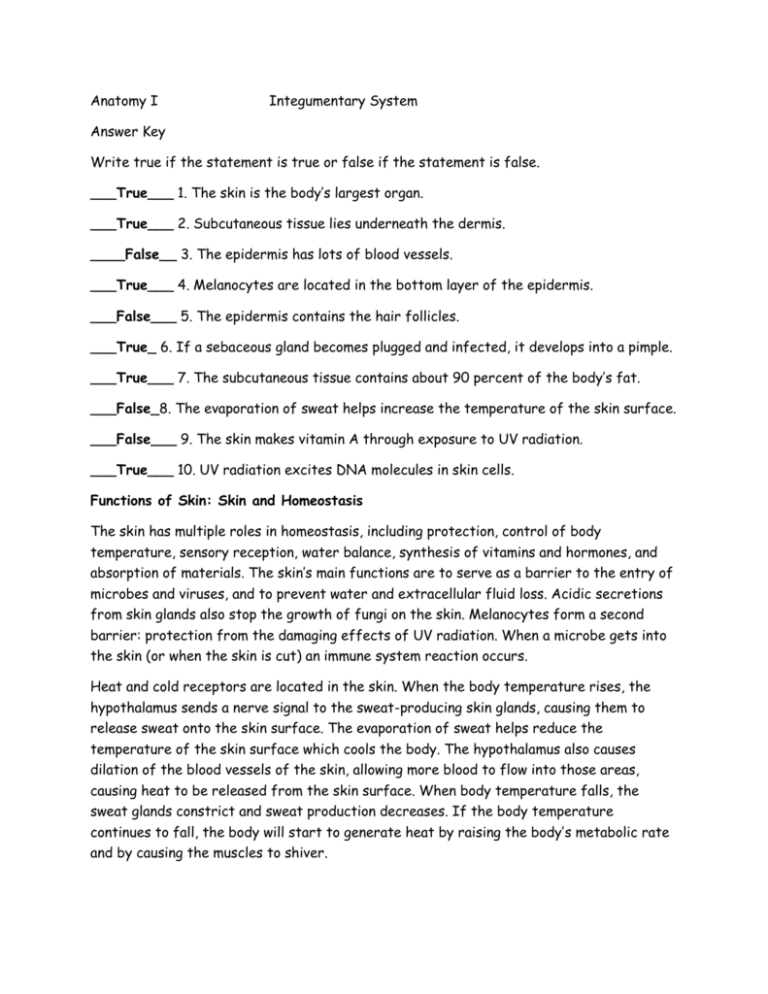
Anatomy I Integumentary System Answer Key Write true if the statement is true or false if the statement is false. ___True___ 1. The skin is the body’s largest organ. ___True___ 2. Subcutaneous tissue lies underneath the dermis. ____False__ 3. The epidermis has lots of blood vessels. ___True___ 4. Melanocytes are located in the bottom layer of the epidermis. ___False___ 5. The epidermis contains the hair follicles. ___True_ 6. If a sebaceous gland becomes plugged and infected, it develops into a pimple. ___True___ 7. The subcutaneous tissue contains about 90 percent of the body’s fat. ___False_8. The evaporation of sweat helps increase the temperature of the skin surface. ___False___ 9. The skin makes vitamin A through exposure to UV radiation. ___True___ 10. UV radiation excites DNA molecules in skin cells. Functions of Skin: Skin and Homeostasis The skin has multiple roles in homeostasis, including protection, control of body temperature, sensory reception, water balance, synthesis of vitamins and hormones, and absorption of materials. The skin’s main functions are to serve as a barrier to the entry of microbes and viruses, and to prevent water and extracellular fluid loss. Acidic secretions from skin glands also stop the growth of fungi on the skin. Melanocytes form a second barrier: protection from the damaging effects of UV radiation. When a microbe gets into the skin (or when the skin is cut) an immune system reaction occurs. Heat and cold receptors are located in the skin. When the body temperature rises, the hypothalamus sends a nerve signal to the sweat-producing skin glands, causing them to release sweat onto the skin surface. The evaporation of sweat helps reduce the temperature of the skin surface which cools the body. The hypothalamus also causes dilation of the blood vessels of the skin, allowing more blood to flow into those areas, causing heat to be released from the skin surface. When body temperature falls, the sweat glands constrict and sweat production decreases. If the body temperature continues to fall, the body will start to generate heat by raising the body’s metabolic rate and by causing the muscles to shiver. The homeostatic functions of the skin include: • Protection of the body’s internal tissues and organs. • Protection against invasion by infectious organisms. • Protection of the body from dehydration. • Protection of the body against large changes in temperature. • Excretion of wastes through sweat. • Acts as a receptor for the senses of touch, pressure, pain, heat, and cold. • Makes vitamin D through exposure to UV radiation. • Stores water, fat, and vitamin D. Questions 1. What do acidic secretions from skin glands do? - The acidic secretions stop the growth of fungi on the skin. 2. How does dilation of the blood vessels of the skin reduce the temperature of the skin surface? -It allows more blood to flow into those areas, causing heat to be released from the skin surface. 3. What can the muscles do to help raise the body’s temperature? - The muscles to shiver causing heat to be produced. 4. How does the skin excrete wastes? -Pores in the skin or epidermis serve as an excretion of wastes Multiple Choice 1. The skin shields the body against ___________. a. heat b. light c. injury d. all of the above 2. . The epidermis contains ____________. a. hair follicles b. blood vessels c. sweat glands d. keratin 3. . Which of the following is composed of keratin? a. the cuticle b. the nail plate c. the lunula d. none of the above 4. What type of hair covers the entire body of fetuses? a. vellus hair b. terminal hair c. lanugo d. none of the above 5. Which is not a function of the skin? a. Protection against mechanical injury b. Regulation of body heat c. Protection against foreign invaders d. All of the above are functions 6. The layer of the skin that lacks blood vessels is: a. subcutaneous b. dermis c. integument d. epidermis 7. The dermis does not contain: a. sebaceous glands b. hair follicles c. mucous glands d. nerves 8. The color of human skin depends on: a. whether the blood within the skin is oxygenated b. the kind and amount of pigment c. carotene d. all of the above 9. Which layer of the epidermis would be generally shed through bathing? a. stratum granulosum b. stratum corneum c. stratum basale d. stratum lucidum 10. The dermis is primarily composed of which tissue type? a. nervous b. muscle c. connective d. epithelial 11. Which epidermal layer is closest to the blood supply? a. stratum basale b. stratum spinosum c. stratum granulosum d. stratum corneum 12. Which of the following is not true about the integumentary system? a. the average adult’s skin weighs about 6 pounds b. skin is flexible and rugged c. the thickest skin on our body is on our face d. the thinnest skin is on our eyelids a. A change to the nucleotide sequence of DNA or RNA. b. The outermost layer of the skin. Match the vocabulary term with the correct definition. __e__ 1. dermis __h__ 2. melanin __b__ 3. epidermis __j__ 4. integumentary system __a__ 5. mutation __c__ 6. sebaceous gland __f__ 7. sebum c. Secretes an oily substance into the hair follicle. d. Lies below the dermis and contains fat and loose connective tissue. e. The layer of skin directly under the epidermis f. An oily substance secreted by sebaceous glands. g. Part of the dermis that contains touch receptors. h. The brown pigment that gives skin, hair __d__ 8. subcutaneous tissue and eyes their color. __g__ 9. papillary region i. Part of the dermis that contains the hair follicles and roots, nerves, and glands __i__ 10. reticular region j. The organ system consisting of skin, hair, and nails . Matching _C__Stratum corneum _F__Stratum lucidium _E__Stratum granulosum __D_Straum germinativum __A_Papillary layer __B_Reticular layer A. Outer layer of the dermis, directly underneath the epidermis B. Supplies the skin with oxygen and nutrients C. Has a layer of oil to help make this layer a protective, waterproof layer D. The deepest layer of the epidermis, responsible for the growth of the epidermis E. Cells looks like granules, and they are pushed to the surface to replace cells that are shed F. A clear transparent layer through which light can pass








